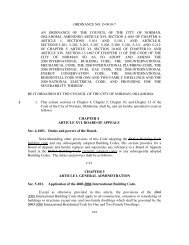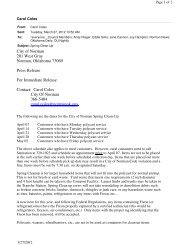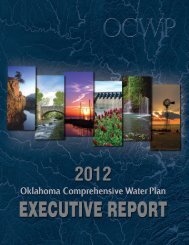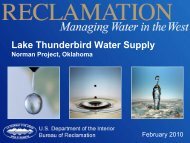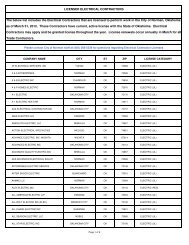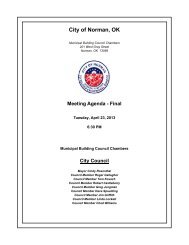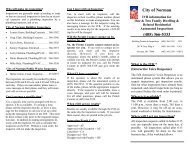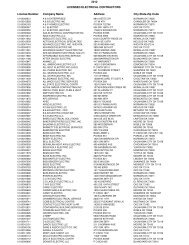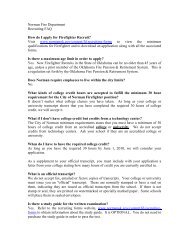2011 Water Conservation Plan - City of Norman
2011 Water Conservation Plan - City of Norman
2011 Water Conservation Plan - City of Norman
Create successful ePaper yourself
Turn your PDF publications into a flip-book with our unique Google optimized e-Paper software.
<strong>City</strong> <strong>of</strong> <strong>Norman</strong><strong>Water</strong> <strong>Conservation</strong> <strong>Plan</strong> <strong>2011</strong>water supply. Each source is currently experiencing problems with either quantity capability orquality.Since the 1960’s, Lake Thunderbird has historically served the majority <strong>of</strong> <strong>Norman</strong>’s waterdemand needs. The annual allotment from Lake Thunderbird is 9,460 acre-feet (3.082 billiongallons). In 1988 <strong>Norman</strong> exceeded the allotment for the first time. Since then, the watertreatment plant use has exceeded the allowed allocation fifteen times. The demands on LakeThunderbird have increased to the point that it cannot provide the <strong>City</strong>’s supply requirements ona continual basis. Figure 6 depicts <strong>Norman</strong> continually increasing demand placed on LakeThunderbird. Only recently efforts were made to operate the well field at a maximum yield toreduce the annual demand from Lake Thunderbird and bring <strong>Norman</strong>’s usage within thepermitted allocation. Projected increases over the next 15 years will only get greater as the cityapproaches 2060.<strong>Norman</strong>'s Lake Thunderbird Usagevs Permitted AllocationMillion Gallons5,0004,0003,0002,0001,00001960 1970 1980 1990 2000 2010 2020<strong>Water</strong> Year (Oct - Sep)UsageAllocationFigure 6.To reduce the demands on Lake Thunderbird, <strong>Norman</strong> began to rely heavily on water productionfrom ground water wells to meet demands. This practice allows <strong>Norman</strong> to limit the extent <strong>of</strong>exceeding the Lake Thunderbird allotment annually. It is uncertain at this time if the well fieldcan withstand this increased pumping strategy over time. Additionally, <strong>Norman</strong> must continueto address increased regulations regarding groundwater. The most impacting rule change wasthe one establishing new limits in the amount <strong>of</strong> naturally occurring arsenic. This rule changeresulted in the loss <strong>of</strong> fourteen wells from service. In addition, another well failed fluoridetesting and one structurally failed. By January <strong>of</strong> 2006, the loss <strong>of</strong> these wells reduced <strong>Norman</strong>’stotal ability to supply water to a peak rate <strong>of</strong> 18.4 million gallons per day.Currently, EPA is reviewing the existing regulatory limits for Chromium. If the current 100parts per billion (ppb) regulation is reduced to a limit <strong>of</strong> 10 ppb or less, it will require most <strong>of</strong> thewell field to be shutdown and/or costly treatment added to continue use. EPA has also recently9




